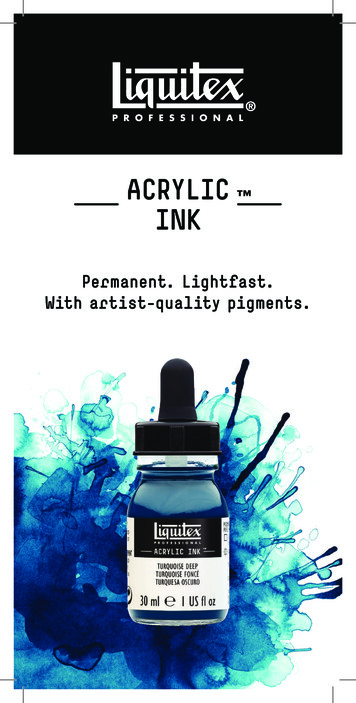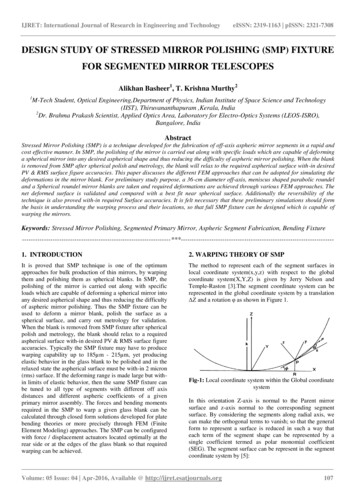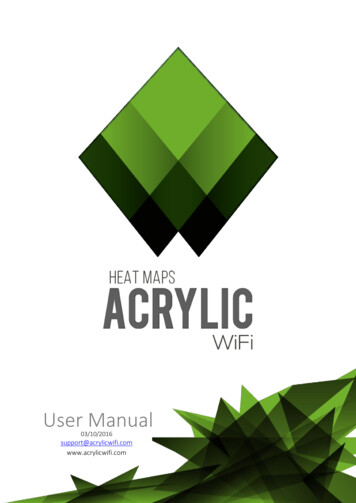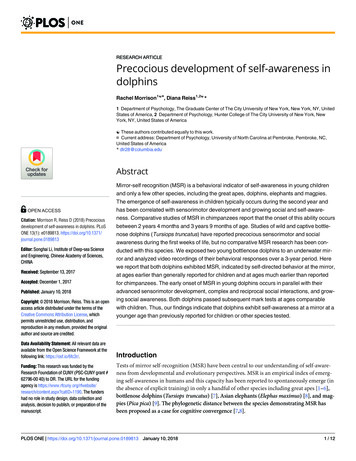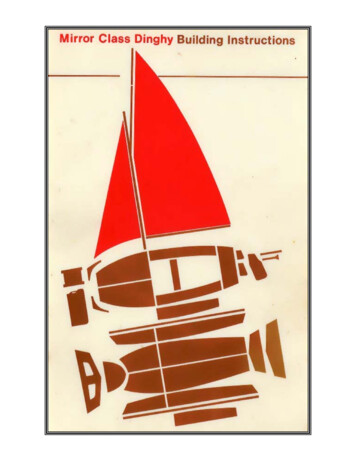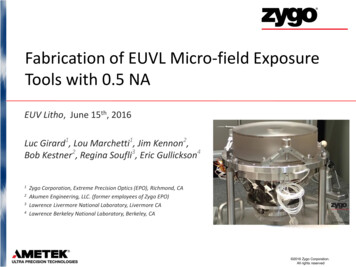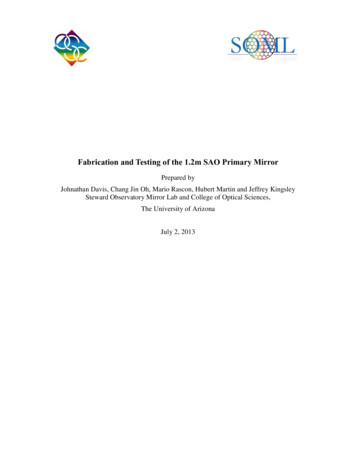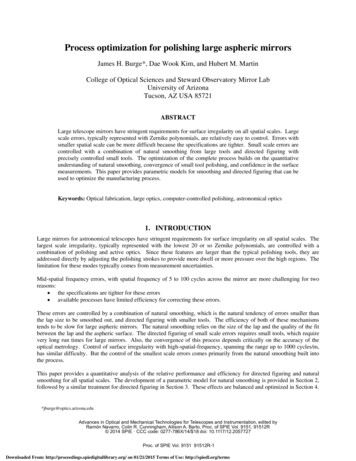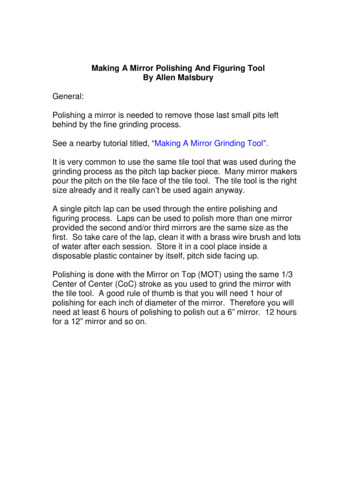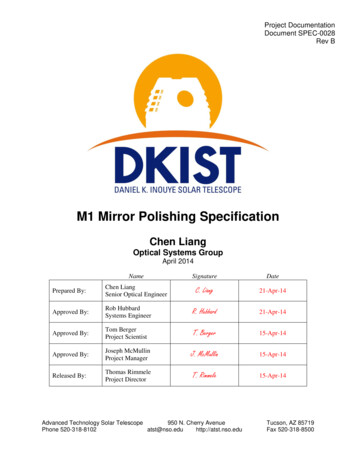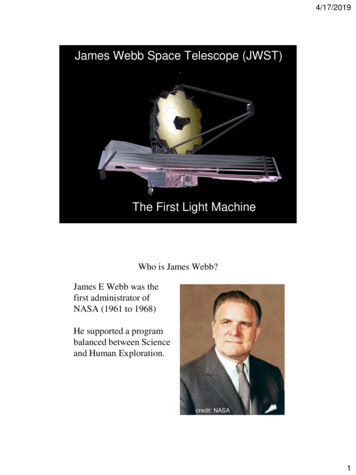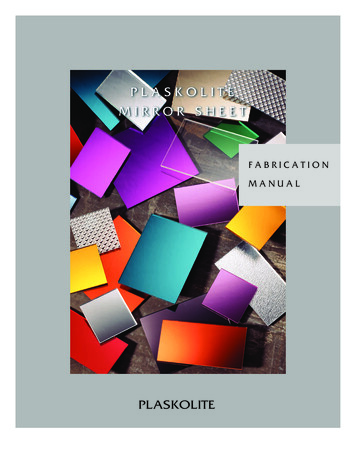
Transcription
FABRICATIONMANUALPLASKOLITE56512 Mirror Covers.indd 110/12/08 9:01:40 AM
Plaskolite's products are strong, lightweight thermoplastic materials that have developed a wide use as a replacementfor glass mirror, especially where the risk of higher stresses is greater, and where safety is a concern. Plaskolite mirrorscan be used as a reflecting surface in decoration, visual merchandising and store design, and frees creative designersfrom the esthetic and physical limitations of ordinary glass. The following outline should acquaint you with theprocedural information necessary to fabricate acrylic, polycarbonate, and PETG mirror sheets into useful products.TABLE OF CONTENTSDos and Don'tsAbout Our ProductsProduct AdvantagesHandling / Maintenance / CleaningCuttingRoutingDrillingEdge and Surface FinishingChemical ResistanceWeather ResistanceCementingMirror BendingFlammability InformationConsultation and AdvicePage 1Page 2Page 2Page 3Page 4Page 5Page 6Page 7Page 7Page 7Page 8Page 8Page 9Page 9DOS AND DON'TS1. Because acrylic has a relatively soft surface and is flexible, some imperfections or distortions may occur. Itshould not be used for precise image reflection. An appropriate thickness should be determined well inadvance of cutting.2. Acrylic mirror can not be thermoformed but can be cold formed.3. Some adhesives attack the mirrored surface. Please test expendable pieces at least 72 hours in advance todetermine suitability.4. Mirror products are not recommended for glazing or any outdoor applications.5. Acrylics tend to absorb moisture. High humidity levels may cause temporary warpage to the material. Thewarpage is characteristic of the material and should be considered in the design of the product or application.6. Solvent gluing at edges may cause crazing.7. Plaskolite acrylic sheet is a combustible thermoplastic. Precautions should be used to protect the material fromflames and high heat sources.8. Acrylic mirror can not be die cut, but can be router, saw, or laser cut.9. Materials should be stored in a cool, dry area. Acrylic sheets will warp if exposed to variable temperatures.Changing humidity levels cause the greatest variation. Material should be stored flat and overwrapped withplastic to minimize absorption of water vapor.10. Overage is provided for your convenience. Check peripheral areas for suitability before cutting.11. Protective masking should not be removed until fabrication is complete. Exercise care during fabrication andhandling of both sides of mirror.12. Do not remask adhesive or paper masking on see-thru or first surface sheet. If required, mask over supplied film.13. Do not use in shower doors, window applications or rooms where humidity could cause the thermoplasticsheet to expand or contract.14. These suggestions and data are based on information we believe to be reliable. They are offered in goodfaith, but without guarantee, as conditions and methods of use are beyond our control. We recommend that theprospective user determine the suitability of our materials and suggestions before adopting them on acommercial scale.156512 Mirror Manual.indd 1PLASKOLITE (614) 294-3281 OR 1-800-848-912410/15/08 10:40:31 AM
about our productsacrylic mirror sheets:The most popular lightweight and flexible mirror substrate available in the widest range of thicknesses, colors andsizes. Acrylic mirror may be saw cut, router cut, or laser cut.PETG MIRROR SHEETS:Higher impact strength than acrylic mirror. Can easily be cold formed, die cut, or punched. These processes aresuitable for high volume. Available in thinner gauges than acrylic.polycarbonate mirror sheets:Recommended for applications requiring high impact strength, heat and flame resistance. The optics of Polycarbonateis comparable to acrylic, but its strength is 30 times stronger.ARMADILLO(AR) coating:In-house processing offers an abrasion, solvent and stain resistant coating on acrylic and polycarbonate one or twosides, mirrored or non-mirrored. Increases and enhances the versatility of the substrate.SEE-THRU MIRROR (TWO-WAY MIRROR):A semi transparent reflective coating for monitoring or surveillance. Available in acrylic clear and colors andpolycarbonate clear and colors.FIRST SURFACE MIRROR:An opaque, two-sided mirror used where a reflection in two directions is desired.FABBACK :A gray paint backing on all of our mirrored sheet products. This backing is the most durable, toughest, scratch-resistantbacking in the acrylic mirror industry.ABM:Adhesive backed mirror. This is used to mount mirror sheet to another substrate or surface. It is a white paper backingthat transfers an adhesive on the sheet once the white paper is pulled off. This replaces adhesives applied by hand thatcan cause messy edges and non-uniform adhesive coverage.PAPERMASK:White or brown papermask, available as additional protection over the Fabback backing for ease of handling,fabrication and working with mirror sheet.PRODUCT ADVANTAGES OF PLASKOLITE MIRRORED ACRYLICReflectivity Approximately 85-90% over the 400-700 nanometer visual light spectrum.Lightweight Less than one half the weight of glass in the same size and thickness.Break Resistance Can be ten times more break resistant and has seventeen times greater impact resistance thanHeatEasy FabricationExtensiveglass of equal thickness.Will tolerate continuous service up to 1600 F, and can withstand occasional short-term exposureup to 1900 F.Various shapes and sizes can be obtained by cutting with conventional power saws and routers,using the proper blades and cutters. Mirrored acrylic can be cold bent for curved shapes orstrip heated for a sharp bend. State-of-art laser systems can produce accurate, complex designs.Available in .060 to .236 thickness. 19 standard colors with custom colors available. Also availableProduct Linein see-thru, first surface and textures.Economical Low fabrication and installation costs.Quality Highly reflective surfaces for use in display, decoration, or other mirror applications.256512 Mirror Manual.indd 2PLASKOLITE (614) 294-3281 OR 1-800-848-912410/15/08 10:40:31 AM
Handling / Maintenance / CleaningHandlingAll Plaskolite mirrored sheets are furnished with a protective masking on the top side of the sheet. Do not slidePlaskolite mirrorized sheets when transporting. The masking should be left on the sheet during storage andfabrication to prevent damage. Plaskolite mirror is shipped in "ready-to-store" condition. Keep away from excessiveheat, paint overspray and vapors from solvents and other chemicals. The materials should be stored in a clean, dry,and warm area with the original packing intact. However, this is not always practical as all or part of theshipment must be unpackaged for the customer to use. In these cases, the following guidelines should be followed:Vertical Storage: If the mirror sheets are to be stored on end, care must be taken to avoid warping. Sheets muststand with an angle of no more than 100 from the vertical. A-frame racks made of plywood canbe made to give full support to the materials.Horizontal Storage: If the acrylic mirror is to be stored flat, care must be taken to avoid warping, slipping andscratching. If different sizes are to be stored together, make sure the largest pieces are at thebottom, the smallest on top. This will prevent overhang which can lead to warping andslipping during movement. Preventing chips or dirt from settling between the sheets willreduce the risk of scratching if a slip occurs, or while unpacking. Pallets are packaged with aheavy poly overwrap which protects the sheet from dirt and moisture. The overwrap shouldbe intact during storage.MaintenanceMasking:Each mirrored product is well protected by a durable paint backing and a removable maskingon the front. This masking should remain in place to protect the sheets during all phases offabrication and installation. Plaskolite plastic sheets should be handled mirror side down,with the masking left on. Care should be taken not to slide sheets against each other.Removing Masking: If there is difficulty in removing the masking, use aliphatic naptha, kerosene, or distilledalcohol to moisten the adhesive. Do not use other chemicals or sharp objects to remove themasking.CleaningWashing: Use a mild soap and a damp soft cloth to wipe the surface of the sheet with lightpressure, avoiding the edges of the sheet. To remove grease, oil, or tar deposits onthe material, use hexane or kerosene to remove them. Do not use any chemicals on apainted print design. Do not use window cleaning sprays, kitchen scouring compounds,or other chemicals to clean mirrorized sheets.Polishing: A surface gloss can be maintained by occasionally using a flannel cloth and good plastic cleanseror polish, such as Johnson's Pledge. Follow the instructions for polishing on the container.RemovingFine scratches can be removed by hand polishing with a plastic scratch remover orScratches: compound cleaner. Remove all residue and polish with a flannel cloth. Deep scratches needto be lightly sanded, using a 400 grit "wet or dry" sandpaper.356512 Mirror Manual.indd 3PLASKOLITE (614) 294-3281 OR 1-800-848-912410/15/08 10:40:31 AM
cuttingScribing AndBreaking:This method is used to achieve a quick, straight line cut of single sheets of Plaskolite acrylicmirror less than .118" (3mm) thick. Mark the line to be scribed (scored) on the Plaskolitemirror with a commercial scriber. Firmly place a straight edge along the line and use it as aguideline for the scriber or knife. Scribe the mirror along the line using several firm, evenlypressured strokes. Then, overhang the end of the mirror off the work table. Break the Plaskolitemirror with sharp downward pressure.Circular Table AndPanel Saw Cutting:These saws are used to achieve a precise, straight line cut of one or more sheets of Plaskolitemirror. Because vibration is minimal, this method of cutting is recommended. The best way toavoid vibration and unwanted runout is to install a stiffener 1/2 to 2/3 the saw blade diameterand mount it against the outside of the blade. To prevent back cutting, the saw arbor, the sawtable and the table fence must be properly aligned. Also, the throat plate (table kerf) must bekept to a minimum. A 10", 80 tooth carbide tipped blade is recommended for all-purposecutting. The blade's teeth should be the triple-chip design, where every other tooth has abeveled cutting edge to help clear away saw chips,. For best results, the teeth should have aclearance angle of 10 to 15 . Material should be cut with masked side down. Any paperinterleaf should be kept intact between sheets to protect paint back coat during cutting.Use enough power to make the needed cuts, using a smooth and even feed rate. Uneven feedrates may produce gumming or chipping of the Plaskolite mirror.Saber Saw Cutting:Saber saws are generally used for cuts involving a frequent change in direction. Maintainingadequate support is important to prevent vibration which may cause chipping. To achieve this,clamp a straight board on the sheet near the cutting line. This may also be used as a saw guide.Set the saw to full speed before cutting the Plaskolite mirror. Without feeding too fast, press thesaw shoe firmly against the mirror while cutting. Blades for saber saws should have atleast 14 teeth per inch.Jig Saw Cutting:Jig saws should be used primarily for inside cuts and intricate letters. Since the stroke is short,the blade heats up quickly and tends to soften and fuse the Plaskolite mirror. To avoid this, usea fast and steady feed rate." Blades for jig saws should have at least 14 teeth per inch.Band Saw Cutting:Band saws are used for cutting curved sections or trimming thermoformed parts. Blades forband saws should have at least 10 teeth per inch.Laser Cutting:Lasers may be used to cut virtually any image on a Plaskolite mirror with minimal materialwaste. The CO2 laser operates by focusing a large amount of energy on a small defined areaand melting and vaporizing the material. It produces a clean, polished edge without any sawchips. An average of 200 inches per minute may be accomplished by using about 200 wattsfrom a 1200 watt laser. Annealing the sheet is recommended after cutting, especially whencementing is anticipated. Caution: lasers can create stresses along cut areas. Be sure to use atest piece before fabrication.CAUTION:456512 Mirror Manual.indd 4A cool air mist should be in contact with the blades of all cutting devicesbefore and during penetration of the plastic.PLASKOLITE, INC. (614) 294-3281 OR 1-800-848-912410/15/08 10:40:32 AM
routingMany routers are available for use in the fabrication process. The router should have a minimum of one horse-powerand a no load speed of about 20,000 RPM. Routers are normally used with a single or double fluted bit, but mayconsist of one to four flutes. Router bits can be carbide tipped, high-speed steel, solide carbide, or diamond tipped.They may be one piece piloted, non-piloted, straight cutting, multiple part, forming or speciality bits.Hand Routing:A hand router is generally used when making a prototype or a replacement part, by using aprecut template pattern clamped to the Plaskolite mirror, the hand held router may besmoothly guided around the pattern. Move clamps whenever necessary.Circle Routing:A circle router would be used when a 3600 piece of Plaskolite mirror is needed."Pin Routing:Pin routers are very flexible. A double-backed tape or vacuum holds the mirror in place. Usingthe mounted overarm router to hold the cutter over a guide pin in the table, feed the mirrorand pattern into the cutter and rotate 3600 to form finished product.Contour Routing:By using a contour jig on a pin routing machine, multiple parts can be manufactured. Cut thedesired pattern on the base of the jig to follow the base guide pin. To secure several Plaskolitemirrors at one time, clamps should be mounted on the top of the work. Be sure to raise andlower clamp holders as necessary when the jig is rotated.ComputerizedNumerical Control(CNC) Routing:CNC routers are used in the manufacture of high volume production. This type of router isdesigned for maximum use of the Plaskolite mirror. Mirrors may be designed for stackingwhich eliminates much of the waste normally produced.Direction of Travel:This router is designed to rotate counterclockwise for external cuts, and clockwise for routingthe inside edges of the Plaskolite mirror. When properly fed in the direction necessary, asmooth cut will result.When operating a router, several precautions are necessary to avoid mistakes to the Plaskolitemirror or the tool in use. First routers are designed with a small diameter and must beoperated at high speeds. Avoid vibrations, even the slightest vibration can cause crazing andfractures in the Plaskolite mirror during routing. Second, watch RPM speeds, higherRPM rates allow for faster feeding of the Plaskolite mirror, resulting in a smoother finish.Recommended RPM speeds are 18,000 to 28,000 RPM. Third, for maximum production,operate the feed rate just below chipping speed. Do not overload the motor. Fourth,maintaining a sharp cutter is very important to avoid chipping and decreased production.Finally, use a 1/2" or larger diameter cutter whenever possible, this larger diameter providesa better surface with less tendency to chip.CAUTION:556512 Mirror Manual.indd 5A cool air mist should be in contact with the blades of all cutting devicesbefore and during penetration of the plastic.PLASKOLITE (614) 294-3281 OR 1-800-848-912410/15/08 10:40:32 AM
drillingPlaskolite mirror may be easily drilled with any commercial power-driven drill available.Included are: portable drills, drill presses, lathes, or automatic multiple-spindle drilling units.Before drilling a hole in a Plaskolite mirror, it is recommended to use a bit offered especially for plastics. If a drill bit forplastics is not available, a metal-working drill bit with a high-speed twist may be used with some modification.Since metal-working drill bits are designed to push through metal the following modifications must be made to ensureno chipping or other damage to the Plaskolite mirror:1.The tip angle is usually about 120 0, this is too flat to cut through Plaskolite mirrorproducts without damage, and must be ground to a sharp angle of 60-900 to allow the bit toenter and exit easily without chipping.2.The cutting edge must be ground to a rake angle of 0-40. This "flat" cutting edge will scrapethe Plaskolite mirror without gouging it.3.The surface behind the cutting edge must be ground away to clearance angles of 12-150.This will allow back relief for reduced metal to plastic contact and heat build up.Drill bits with tips larger than 5/8" should be ground to a point to reduce the amount of force required to start a hole.Drill bits must be true, or melting, burning and chipping may occur. Correctly modified drill bits will create twocontinuous spiral strips as the bit passes evenly through the Plaskolite mirror, when operated at the proper speed.When drilling the actual Plaskolite mirror back up the surface with a durable surface, such as plywood,so the drill bit will continue into a solid material, this will prevent chipping on the opposite side of thePlaskolite mirror. A slow feed rate should be used when the bit enters or exits the Plaskolite mirror.Holes of 1" or more may be cut with a circle cutter. To accommodate the material properties of Plaskolite mirror, thecutter bit must be modified so the tip scrapes the material without gouging it. Use a cool air mist system to avoid heatbuild up, leaving the walls of the hole with a smoother cutting edge. Use a drill press for uniform pressure andconstant vertical positioning.CAUTION:656512 Mirror Manual.indd 6A cool air mist should be in contact with the blades of all cutting devicesbefore and during penetration of the plastic.PLASKOLITE (614) 294-3281 OR 1-800-848-912410/15/08 10:40:32 AM
edge and surface finishingThe extent of finishing needed to produce a smooth, transparent edge is based upon the quality of the cuttingtool used to machine the edge. A properly designed cutting tool with a sharp cutter will reduce the amount offinishing needed. Finishing is also reduced when a spray coolant is used along with the cutting tool to reduce excessheat build-up.Polishing:A polished edge is the best possible finished edge, but requires the most preparation. Priorsanding is necessary if the edge is shaped from a saw-cut. Sanding is not necessary whenthere is a well milled edge. A jointer, shaper, or hand-scraped edge can be used in place ofsanding. A stationary polishing head produces the best polished surface. Bleached muslinwheels with a diameter of 8" to 14" with bias strips is recommended. This gives the buffingwheel a pleated appearance, runs cooler than a stitched buffing wheel design and decreasesthe processing time.PolishingCompounds:The finished quality of the polished edge is determined by the polishing compound used.To produce a high luster finish, first use a fast cutting compound to remove all sandingmarks, then use a high luster compound for the final buffing. To achieve a good finishin one operation, a medium cutting compound would be best.PolishingSurface:Prior sanding is not necessary when the scratches or machining marks are not too deep. Asurface polishing wheel should be from 6" to 12" in diameter, built up to a width for 1 1/2"to 2". For the initial polish, use a soft, bleached muslin wheel, followed by a soft flannel wheelfor the finishing.Depending on the depth of the scratches, use a medium-course polishing compound ora fine compound.Be sure to keep the Plaskolite mirror in motion at all times during the polishing procedure.CHEMICAL RESISTANCELike all plastic materials, Plaskolite mirrored acrylic will react when exposed to many chemicals. Below is a partial listof chemicals known to react with Plaskolite acrylic mirror, exposure to them should be avoided, Factors such asfabrication stresses, exposure to loads or changing temperatures and the method of application can all influencethe possible reaction. In all cases, care should be taken with dry chemicals or solvents used near Plaskolitemirrored acrylic.KNOWN CHEMICALS THAT ATTACK PLASKOLITE MIRRORED ACRYLIC:BENZENELACQUER THINNERSESTERSCARBON TETRACHLORIDETOLUENEETHYL ALCOHOLKETONESMETHYL ALCOHOLETHERSWEATHER RESISTANCEMirror products are not recommended for exterior use. If used outside, seal perimeter with silicone sealant to keepmoisture out and protect mirror paint backing. Salt spray can also begin to degrade mirror.756512 Mirror Manual.indd 7PLASKOLITE (614) 294-3281 OR 1-800-848-912410/15/08 10:40:32 AM
CementingMirrored acrylic is a reflective film applied to a substrate. When the substrate is affixed to another surface, both ofthese materials will in time conform to the irregularities of the supporting surface. A non-smooth, non-planar surfacewill cause localized bending of the mirrored sheet and distortion in the reflected image.For best results, mirrored sheets should be mounted to a smooth, rigid, sturdy flat backing such as 5/8" or 3/4"plywood. The surface should be coated with a high quality primer sealer to cover pockets and seal out moisture. Theentire surface should then be covered with a mastic or another type of pressure sensitive adhesive.Solvent cementing of a mirror sheet with a hard-coated surface is difficult due to the chemical resistance of the coating.Another option is to drill oversized holes in the mirrored acrylic and secure it to the wall using screw fasteners. Do notover tighten the screw fasteners. Over tightening will cause dimpling and distortion.Visual distortion is a function of viewing distance and material thickness. A thicker piece of material will be less flexibleand therefore maintain better optical integrity. Correct installation and sufficient material thickness can reduce visualdistortion but may not completely eliminate it.Ceiling and overhead installations are not recommended unless the mirrored acrylic is mounted in edge-engagingframes such as T-bar suspended ceiling frames or mechanical mounting.Some adhesives may contain solvents such as toluene, ketones and hexane that can attack the backcoat. Adhesiveswith solvents of 5% or more are not recommended. Since numerous adhesives, cements, and mastics are available,they should be tested on expendable pieces prior to application. All tests should be applied at least 72 hours inadvance to determine compatibility to the backcoat, the reflective coating and the acrylic itself. The followingcompanies manufacture adhesives that are suggested for use with Plaskolite mirror:3MSt Paul, MinnesotaPhone # 800-362-3550Products 3M560 Polyurethane Sealant 3M Super 77 Clear Spray 9500 PC Double Coated Polyester Tape VHB TapeAgain we stress, before using any adhesives, cements, or mastics, please test expendable samples for atleast 72 hours to determine suitability.Mirror BendingLine or strip bending is best accomplished by applying an intense narrow band of heat approximately .118" (3mm)away from the mirror substrate. 1.15mm nichrome (nickle-chrome) resistance wire is a commonly used heating element. Place the mirror face toward the heating element. Do not attempt to heat the paint side. Doing so willprolong heating times and cause blushing, a dulling of the mirrors reflective finish.Adjust your power source so that the wire becomes a medium to bright red color. Peel all masking several inches away from the bend area. Masking left in place, either poly orpaper, will increase heating time and yield poor results. Acrylic will become bendable at 143 degrees C to 163 degrees C. Bending should be doneat the coldest possible temperature requiring gentle force to make the bend. 3mm mirrorshould become pliable enough to bend within 20 to 25 seconds. Timing is critical. Under heating will cause warpage along the bend line and undue stresswhich may lead to cracking. Overheating will cause blushing. 856512 Mirror Manual.indd 8Cooling should be done as quickly as possible by air circulation.PLASKOLITE (614) 294-3281 OR 1-800-848-912410/15/08 10:40:32 AM
flammability informationAcrylic mirrored sheet is a combustible thermoplastic. Precautions normally used to protect wood and other combustiblesfrom flame and high heat, should be observed with this material. It is recommended that appropriate building codesbe followed to ensure proper and safe use.IMPORTANTNOTICE:Careless handling of the product can result in injury. The same precautions should beexercised when using acrylic mirror that are taken when fabricating glass, plastic, orwood to prevent accident or ingestion.CONSULTATION & ADVICEOur toll free number gives you access to a responsible person who has many years of experience working withmirrored acrylic in a multitude of varied applications. We cannot guarantee that we will always have a solution to aparticular problem, but our working knowledge is quite extensive and available to you without cost.Cutting To Size: Cost Savings can sometimes be realized by using our in-house cutting services. We have both theskilled people and precision equipment to meet your needs. Whether it is with our two large circularsaws or our small, more personal, table saw, we can provide our customers with the exactmaterials they need.Laser Cutting: For accurate, complex cutting, lasers have an advantage over traditional saw or router cutting.Clean lines, safe smooth edges and varied patterns contribute to the design attractiveness of thefinished piece.This manual is a general guide for working with PLASKOLITE FABBACK acrylic mirror,polycarbonate and PETG mirror sheet products. Because actual results vary with differences inoperating conditions, thickness, color and composition of the mirror sheet, nothing contained hereincan be construed as a warranty that PLASKOLITE'S mirrors will perform in accordance with thesegeneral guidelines.Importance Notice: Our recommendations, if any, for the use of this product are based on testsbelieved to be reliable. The greatest care is exercised in the selection of raw materials and in themanufacturing operations. However, since the use of this product is beyond the control of themanufacturer, no guarantee or warranty expressed or implied is made as to such use or effectsincidental to such use, handling or possession of the results to be obtained, whether inaccordance with the directions or claimed so to be. The manufacturer expressly disclaimsresponsibility therefore. Furthermore, nothing contained herein shall be construed as arecommendation to use any product in conflict with existing laws and/or patents coveringany material or use.Anyone experiencing problems with fabricating PLASKOLITE'S mirror sheet products, should referthose questions to the Inside Sales Department at 1-800-848-9124.956512 Mirror Manual.indd 9This brochure does not constitute an offer to sell by Company. The Company sells ONLY under itscurrent Terms and Conditions of Sale which appear on its acknowledgments and invoices. Acurrent copy of the Company's Terms and Conditions of Sale will be supplied upon request. Thedetails provided are believed to be accurate at the time of publication; however, no description is awarranty that the product is suitable for any particular application. THE COMPANY MAKES NOWARRANTIES, AND UNDERTAKES AND ACCEPTS NO LIABILITIES, EXCEPT ONLY AS SET FORTHIN ITS CURRENT TERMS AND CONDITIONS OF SALE.PLASKOLITE (614) 294-3281 OR 1-800-848-912410/15/08 10:40:32 AM
PLASKOLITEMATERIALEXCELLENCEPLASKOLITEP.O. BOX 1497 COLUMBUS, OHIO 43216 (614) 294-3281FAX (877) 538-0754Email: plaskolite@plaskolite.com Website: www.plaskolite.comFor the location of the Plaskolite Distributor nearest you, call12/16-DIG.VER.1/56512 Mirror Covers.indd 21-800-848-912410/12/08 9:01:41 AM
Polishing: A surface gloss can be maintained by occasionally using a flannel cloth and good plastic cleanser or polish, such as Johnson's Pledge. Follow the instructions for polishing on the container. Removing Fine scratches can be removed by hand polishing with a plastic scratch remover o
